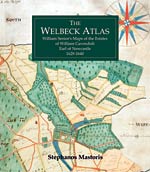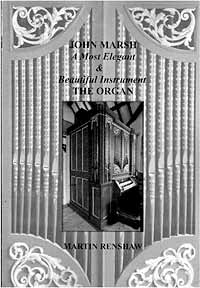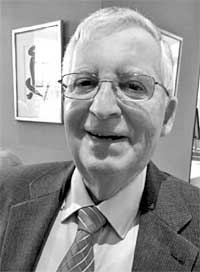News for Autumn 2017
Bookcase

The Society is delighted to report that the Welbeck Atlas, William Senior’s Maps of the Estates of William Cavendish, Earl of Newcastle 1629-1640, has now been published as volume 47 in the Thoroton Records Series. The book includes an innovation, in so far as Thoroton is concerned, in that there is, in a pocket inside the back cover of the book, a credit-card sized USB stick from which the full set of maps can be uploaded into a computer. Copies of the book have been distributed to all subscribers to the Record series. Members of the Thoroton Society who are not subscribers to the Records Series can obtain a copy of the book at £20 from Rob James, rob.james1805@btinternet.com. Non-members can obtain a copy at £30, again from Rob.
The book is selling well. Get yours whilst stocks last! We hope to publish a review in a future Newsletter.
St. Mary’s Church, Bleasby - a remarkable organ

On Saturday 9th July members of BIOS, the British Institute of Organ Studies, came to Bleasby for a special day conference entitled “A most elegant and beautiful instrument - John Marsh’s house organ ‘rediscovered’.
It has long been known locally that the organ in St Mary’s church is very old, built in 1783, was much travelled and had been in a family called Marsh since it was built, the Reverend John Marsh having recorded its history in his farewell address to his Bleasby parishioners given in 1874. But organ experts did not know what had happened to it after its first owner, John Marsh, died in 1828. It was only fairly recently that we in Bleasby became aware that this John Marsh, the Revd Marsh’s grandfather who had designed and owned the organ, was a celebrated 18th century composer, a musician, author and polymath, who kept a regular and detailed journal, had family connections in Southwell and had actually played the Minster’s organ when he visited the town - his journal records his low opinion of the Minster’s organist of the time.
John Marsh was a gifted and largely self-taught musician who composed much music including for the organ, for voices and for orchestral ensembles. He was adept at organisation as well, taking on the subscription concert programmes in Chichester and Canterbury. His journal is a wonderfully detailed account not only of his life and interests but also of 18th century English provincial life. They have been painstakingly edited by Brian Robins in two volumes under the title “The John Marsh Journals” and are published by Pendragon Press. In time for the Organ Conference another publication was prepared entitled “A Most Elegant and Beautiful Instrument: John Marsh’s Organ”. This was written by Martin Renshaw, organ maker and restorer whose mother, unknown by him, lived as a child in Bleasby and would have heard this organ, on which he did such a lot of work, regularly on Sundays.
The story of the organ is that it was a house organ, made and specially designed to the specifications of John Marsh for his newly inherited Nethersole House in Kent - he records that it fitted very nicely into an opening made between the hall and parlour - as it had a console at each end, it could be played in two rooms at once. It has now only one console, but this is an original. On his death it became the property of his son Edward Gerrard Marsh and it moved around with him to three far-afield vicarages ending up, on his death, in Bleasby Vicarage in 1863. The Revd John Marsh, Edward’s son, gave it to St Mary’s in 1869 and so it became a church organ, a lovely looking instrument and with a sweet tone.
The outcome of the BIOS conference was that our organ was declared unique and largely in its original state - “a remarkable survival”. It is also the best documented organ in Britain (because of the journals, Revd John’s address and the records of organ manufacturers and restorers). It is probably one of the most travelled organs too, having been moved seven times before settling in Bleasby Church. As one of the organ experts said “There are old organs and organs that move around a lot but there are very few that move around a lot and survive to be old!” The next step is to have it listed - with its connections to John Marsh and its mainly original state, it is likely to be a grade 1.
There are CDs of John Marsh’s music available as well as some in published form.
Barbara Cast
Archaeology at Kelham Hall
We are delighted to announce that we will be working on an exciting new HLF-funded Community Archaeology project alongside Involve Heritage CIC and partner organisations at Kelham in Nottinghamshire, entitled 'Kelham Revealed!'. The project builds on the work we did between 2014-16 on the 'Kelham in the Civil War' project - see Transactions of the Thoroton Society 2016 volume 120) and
It will see us widen the research scope to explore the origins and location of the Medieval village at Kelham, the church, the early halls, further work on the Civil War and the abandonment of the early village and the building of the new one sometime around the mid-late 16th century. Our scope is to research from prehistory through to the 17th century. We will be undertaking map and documentary research, landscape studies, geophysical surveys, test-pit excavations and building surveys within the village itself, plus landscape work within the grounds of Kelham Hall, something which has never been undertaken previously due to access. The new owner of Kelham Hall has entered into a Partnership with us for the project, and fully supports and encourages our work there -a hugely exciting opportunity for local people to be involved in!
The project will culminate in the creation of a Community Heritage Room within Kelham Hall, which will showcase our discoveries through maps, historical information, artwork and artefact displays. Work on the project is due to start in September, and further details of day/time/venue will follow for those interested. If you would like to sign up to be involved in the project, please email matt@involveheritage.co.uk More information on the project can be seen at http://www.involveheritage.co.uk/proiects/kelham-revealed/
Matt Beresford
Nottingham: the Place of Caves
The city of Nottingham, largely built upon a bedrock of soft sandstone, contains a unique and rich subterranean heritage reflecting much of the story of Nottingham over a period of more than one thousand years.
Ever since Asser wrote in 893, in his work The Life of Alfred, that Nottingham could be described as Tigguo Cobauc (which translates from archaic Welsh as 'place of caves'), part of Nottingham's identity has been entwined with the hundreds of manmade caves, some of which are up to 150m in length. Caves have been hewn into the soft rock from the early medieval period through to modern times. The caves are important because they reflect the development of the city and have been used for so many purposes, thereby offering an insight into Nottingham's social and economic past over a period of more than a millennium. Some of the most commonly known uses include: beer cellars; wine cellars; commercial cellarage for other produce; domestic cellars; malt kilns; tanneries; catacombs; passages; sand mines; gaol cells/dungeons; Victorian follies; air raid shelters.
There are some less commonly known uses, although these were often a secondary function for caves, including the growing of mushrooms and the carrying out of scientific experiments. In the 19th century tests were undertaken in a number of Nottingham's caves to assess the rate of development of tadpoles by reducing their exposure to light. In the 1970s the University of Nottingham measured cosmic rays in a cave at Brewhouse Yard which is now known as the Cosmic Ray Cave.
Despite their importance in Nottingham's past relatively little is actually known about a number of aspects relating to the caves. In terms of function it is often possible to establish what a particular cave was used for, especially if it is located under a current or former place where beer was sold. Occasionally features within the cave offer clues, especially in the case of tanneries, malt kilns and beer cellars. We can often state a cave may have been used for storage but the type of produce stored is not always clear.
Another aspect of our knowledge that needs developing is establishing the age of individual caves. In most cases we do not know how old a cave is, although it is sometimes possible to date them quite broadly and documentation sometimes provides some clues. Some caves have dates inscribed within them, but these are very rare.

Locations of known caves under the centre of Nottingham Map courtesy of Scott Lomax.
The largest, and most problematic, gap in our knowledge relates to knowing how many caves there are in the city. Although approximately 800 caves are recorded in the Nottingham City Historic Environment Record, which is continually updated, it is likely that hundreds more caves exist beneath the city's streets. This is a common issue in archaeology; we do not have a full record of archaeological remains, and cannot expect to d" However, with some effort it is possible to identify sites where caves exist even if they are no longer accessible or indeed visible (having been blocked or built over) and make educated predictions as to where other caves are likely to be. Cataloguing the caves began in the late 1970s when efforts were made by Nottingham City Museums Field Archaeology Section to record, with an index card system, those in the city centre, primarily focussing on the Lace Market.
In 1989 the British Geological Survey (BGS) published its Register of Nottingham Caves, the first published record of caves in the city, using the City Council's records, as well as other records including those held by the University of Nottingham and Nottinghamshire Archives. The BGS also visited a number of caves. The Register at first contained a total 419 cave records, and was later updated to include a total of approximately 460 caves.
Between 2008 and 2010 Nottingham City Council compiled records for a further 90 caves and a few more were found when the City Council developed its Historic Environment Record in 2012 and 2013. The Nottingham Caves Survey Project identified another two (and recorded in detail approximately 80 caves) and a few other caves were revealed during development between 2013 and 2017. In most cases caves were only added to the council’s records when they were found during development.
Not knowing where caves exist is a serious issue because it means often caves are not being taken into consideration as part of the planning process and large numbers of caves have only been found during construction work. For example, in 2013 three caves were unexpectedly found in Radford during residential development. Had the site been within the city centre then the potential for caves would have been considered but there were no known records of caves in this particular area of Radford and so no investigations were undertaken prior to construction commencing. At this advanced stage it is often too late to alter the design of a new building and so the caves are usually filled with concrete, sometimes without an archaeologist even being informed.
The best way to ensure a cave is protected is to know about its existence. By knowing where caves exist, or by having a strong evidence base to predict where caves are likely to exist, then these important historic remains can be fully considered at the earliest stages of the planning process, in order to ensure development takes place without causing any damage to the cave.
To this end I have been making public appeals and carrying out new research into caves, using archival sources. It is the first time that detailed documentary research has been undertaken with the specific aim of locating caves, and it has achieved very good results. Through this work I have identified 153 more caves since 1 July 2016. 111 of these were identified, and added to the Historic Environment Record, between April and July 2017 alone. I still have approximately 400 archive documents to work through so this figure can be expected to rise greatly in the coming months.
Anyone who is aware of a cave which they think might not be known to the City Council is encouraged to contact me at Scott.lomax@nottinghamcity.gov.uk
Scott Lomax
Alan Langton BEM

Congratulations to our Excursion Secretary, Alan Langton, who has been awarded the British Empire Medal for his services to the community in Mapperley and Arnold, Nottinghamshire. We hope to be able to publish a photograph of Alan receiving his medal from the Lord Lieutenant of Nottinghamshire in a future issue.
Alan was a teacher, having taught at Eastwood Hall Park School and Carlton le Willows School, before being appointed to the Headship of South Wolds School at Keyworth in 1981. He retired from this post in 1994 after thirteen very happy years there. Alan was licenced as a Reader in the Diocese of Southwell in 1963, and has served the parish of Saint Mary’s Arnold for fifty-four years, working with seven different vicars during that time. In 1986 he was one of the founders of the Rotary Club of Arnold and Mapperley, where he is still a member. He has also been the local representative for the Leprosy Mission in the area, and helped to help raise large sums of money for this international cause over the last thirty years.
After retirement, Alan founded the ‘Arnold Golden Eagles’, a group especially for older citizens where they could find out more about the workings of the various health, council and social service organisations that affect their lives. This group is a sub-group of the Arnold Area Forum, which Alan has represented on the county-wide Older People’s Advisory Group (OPAG), the object of which is to try and ensure that local issues of older people are heard by the County Council when the latter are formulating strategies for the county.
Geoffrey Bond Research Award
Just a reminder that 1st September is the date on which applications for a research grant from the Geoffrey Bond and Thoroton Society fund. So any of you researchers who are finding that you need some financial support for your research activities, please send in an application. The details are on the Society’s website and were also in the last edition of the newsletter.
Barbara Cast, Hon. Secretary
ANNIVERSARIES
300 years ago - 1717
Abel Smith, of the Smith banking family, was born on 14th March 1717. He was a grandson of Thomas Smith, who founded the Nottingham Smith’s Bank.
‘The Common Seal of the Corporation of Nottingham was affixed to a Petition, praying that His Majesty would be pleased to grant a Charter of Incorporation to the Company of Linen Drapers in the Borough’. Thomas Trigge was mayor; John Radforth and Joseph Walters were sheriffs - Nottingham Date Book
200 years ago - 1817
August 3 ‘A very unseemly and indecent Contest took place this day (Sunday) in the General Baptist Chapel, Stoney Street, between the pastor, the Rev Robert Smith, and a portion of the members of the Church, for the possession of the Pulpit, which ultimately led to a disruption in the church. Mr Smith and his supporters afterwards removed to a chapel they built in Broad-Street; and the Rev Wm Pickering became the minister at Stoney-Street’ - Nottingham Date Book [Does any member know anything about this situation at the Stoney Street chapel? - Ed]
100 years ago - 1917
The Thoroton Society’s Transactions included a Notice to Members. ‘The Annual Subscription of 12/6d [62p] is due on the 1st of January in each year. Members are reminded that a punctual payment saves much trouble to the Treasurer, whose work is honorary’. [Current membership please take note - Editor & Treasurer].
On 31st December 1917 there were 271 subscribing members, three honorary and three associate members. The strain of the war had taken its toll on the activities of the Thoroton Society and other such organisations. A proposed visit to Lynby [sic] and Papplewick was abandoned owing to the impossibility of making the necessary arrangements. The Annual Meeting was held on 28th March at Bromley House, when Major T.W. Huskinson read a paper entitled “Rural Economy of the Past”. ‘The research in connection with the Roman Tesserae at Barton still claims the attention of the Sub-Committee appointed some time ago to deal with this interesting relic of the Roman occupation’.
The Society was involved in the Patriotic Fair held in the Great Market Place during the week 28th May to 1st June. Mr Harry Gill was chiefly instrumental in compiling an excellent guide to the City, which met with a ready sale.